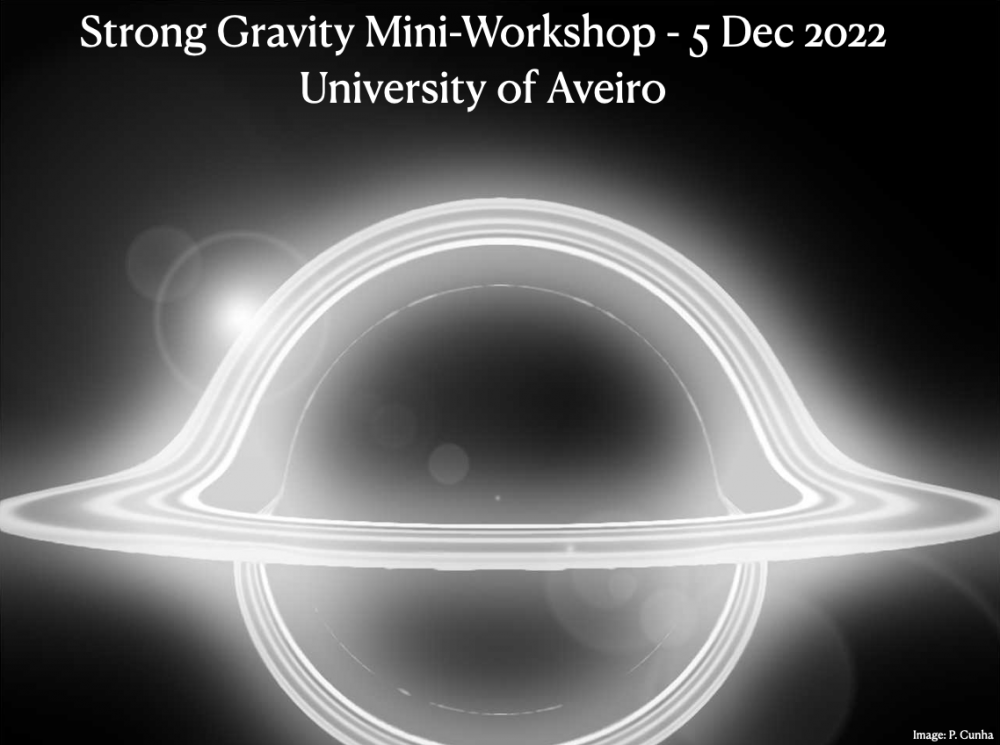Our group is organizing a 1-day strong gravity mini-workshop on Dec 5th 2022.
This will be a face to face event only. All interested are welcome to attend.
Venue:
Mathematics Department, Aveiro University
Morning - Room Sousa Pinto
Afternoon - Room 11.2.21
Schedule:
9H00-10H30 Romain Gervalle - Lecture 1
--------------------------------------
10H30-11H00 Coffee Break
--------------------------------------
11H00-11H30 Talk 1 - Jose Blazquez-Salcedo
11H30-12H00 Talk 2 - Fech Scen Khoo
--------------------------------------
12H00-14H00 Lunch
--------------------------------------
14H00-15H30 Romain Gervalle - Lecture 2
15H30-16H00 Talk 3 - Tigran Tchrakian
--------------------------------------
16H00 - 16H30 Coffee Break
--------------------------------------
16H30 - 17H30 Discussion
----------------------------------------
Abstracts:
Course - Romain Gervalle
Title: Introduction and applications of the Finite Element Method with FreeFem++.
Abstract: This lecture is an introduction to the Finite Element Method for solving Partial Differential Equations (PDEs) with some practical examples using the FreeFem++ software. The first session will be dedicated to the mathematical derivation of the method. We will discuss the variational formulation of PDEs, the discretization of the problem via the finite element space and the obtention of an algebraic system of equations which determines the numerical solution. We will also consider briefly the use of the Newton's method to solve the algebraic system when the PDE is nonlinear and present a link with the Lagrangian formalism. During the second session, the FreeFem++ solver will be introduced. It is based on the C++ syntax and includes many built-in functions to apply the Finite Element Method with a very user-friendly framework. We will first consider two simple examples of linear PDEs, then move on to a physical application: the numerical construction of axisymmetric electroweak monopoles which involves solving a coupled system of nonlinear elliptic PDEs.
—————————————————————————————————
Talk 1 - Jose Blazquez-Salcedo
Title: Quasinormal modes of slowly rotating Kerr-Newman black holes I
Abstract: In this talk we will discuss the quasinormal modes of slowly rotating Kerr-Newman black holes. We will make an introduction to the perturbative double expansion method, considering second order in rotation and first order in non-radial perturbations. We will analyse different families of modes, compare them with previous results, and check the validity of the method.
—————————————————————————————————
Talk 2 - Fech Scen Khoo
Title: Quasinormal modes of slowly rotating Kerr-Newman black holes II
Abstract: In this talk we will discuss the quasinormal modes of slowly rotating Kerr-Newman black holes. We will make an introduction to the perturbative double expansion method, considering second order in rotation and first order in non-radial perturbations. We will analyse different families of modes, compare them with previous results, and check the validity of the method.
—————————————————————————————————
Talk 3 - Tigran Tchrakian
Title: Higgs--Chern-Simons gravity in all odd dimensions
Abstract: Chern-Simons (CS) densities descend from Chern-Pontryagin (CP) densities via a one-step descent. Chern-Simons gravity (CSG) in every (odd) dimension results from the passage of Yang-Mills fields to gravitational fields, and consists of a specific linear combination of all possible higher-order gravitational Lagrangians (Cosmological constant, Einstein-Hilbert, Gauss-Bonnet,...) in the given dimension. It turns out that the Black Holes of CSG in all dimensions are described by the same lapse function N(r).
Higgs--Chern-Pontryagin (HCP) densities result from the dimensional descent of CP densities over a compact--coset space and like the latter, are total divergence. Then, Higgs--Chern-Simons (HCS) densities result from the one-step descent of the HCP densities. Passage of HCS to gravitational coordinates then results in Higgs--Chern-Simons gravity (HCSG), the leading term of which is the CSG density.
While CSG systems are described by (Spin-connection, Vielbein), the HCSG are in addition described by a (gravitational) frame-vector field, inherited from the Higgs field.
——————————————————————————————
Organizers:
C. Herdeiro and E. Radu
